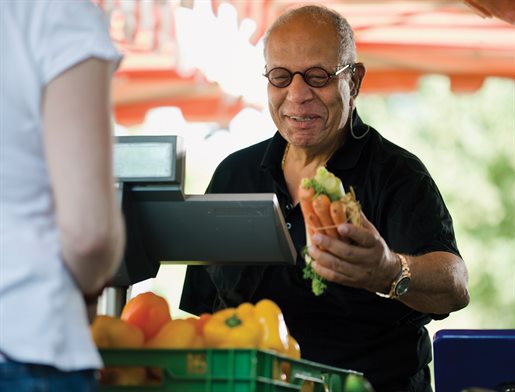How do people communicate in our ever-more diverse cities? Professors Angela Creese and Adrain Blackledge are finding out.
Globalisation and changing patterns of migration mean that ‘superdiverse’ cities are increasingly populated by speakers of multiple languages. Researchers from the University of Birmingham are conducting detailed observations which will generatenew knowledge about communication in changing urban communities.
Angela Creese, Professor of Educational Linguistics in the School of Education, believes there is a pressing need to understand how people communicate in increasingly diverse neighbourhoods: ‘Multilingualism is often characterised as a problem, but in our research we are finding that it is a resource for communication and understanding,’ she says. Angela is leading a four year research project, Translation and Translanguaging: Investigating Linguistic and Cultural Transformationsin Superdiverse Wards in Four UK Cities, part of the Arts and Humanities Research Council Translating Cultures theme.
Teams in Birmingham, Cardiff, Leeds, and London are conducting detailed linguistic ethnographic investigations in selected wards. Researchers from Birmingham, Birkbeck (University of London), the University of Leeds, and Cardiff University will focus on multilingual interactions between people in the contexts of business, legal advice, community sport, and libraries and museums. Analysis will provide detailed evidence of how people communicate across languages and cultures.

The project is being run in collaboration with a wide range of partners from private, public, and third sectors, including Migrants’ Rights Network, Library of Birmingham, Business in the Community, Birmingham Museums Trust, Law Centres Network, Sporting Equals, Equality and Human Rights Commission, and Midland Heart. The research also benefits from the expertise of international specialistsin multilingualism and superdiversity.
In the last few months researchers have conducted ethnographic observations of people as they come into contact with each other when they speak different languages with different proficiencies. In Birmingham the research team has focused on the Bull Ring Indoor Market, audio-recording, video-recording, taking photographs, interviewing, and writing notes as people from all over the world buy and sell chickens’ feet, pigs’ hearts, soft-shell crabs, and conger eel.
Already researchers have seen that language use in the markets is as much about finding common ground as about difference. Angela Creese says: ‘We are seeing people joking, teasing, haggling over prices, negotiating, arguing, pointing, gesturing, and, most of all, using whatever communicative resources are available to complete the interaction’.
The multi-university, interdisciplinary research team is observing small migrant businesses in four ‘superdiverse’ wards in four cities, before moving on to observe cultural heritage sites in the same neighbourhoods. The project teamdefines ‘superdiversity’ not merely as ‘more people from more ethnic backgrounds’, but as a description of changing demographics in which other variables (eg, legal status, immigration history, social class, educational background) influence the composition and trajectories of urban centres.
The research team consists of peopleat different points in their research careers, from doctoral researchers to senior professors. Four of the project Research Fellows are bilingual in English and at least one other language, including Arabic, Czech/Slovak, Mandarin, and Polish. These bilingual researchers are crucial to the success of the project, enabling the research team to collect and make sense of multilingual communication.
Adrian Blackledge, Director of the University of Birmingham’s MOSAIC Centre for Research on Multilingualism says, ‘What we see in superdiverse neighbourhoods is people ‘translanguaging’, as they communicate through a range of linguistic resources’. A focus on translanguaging enables the researchers to see how everyday practices and identities are rooted in the trajectories of the multiple communities to which individuals belong, and how they develop and transform.
In Birmingham Bull Ring Indoor Market some of the traders had learned a few words of their customers’ languages. One of the butchers said: ‘I know some of the basic Chinese words anyway, so it’s not too bad.’ The market traders believe that immigration is keeping their economy afloat, as migrants make up a large proportion of their customers.
Angela Creese says that even at this early stage of analysis it is clear that in cities characterised by a ‘diversity of diversities’ multilingualism is a commonplace practice: ‘Our observations capture the sights, sounds, smells, actions, and relationships in shops, markets and community centres. We listen into people’s everyday communication. We are hearing richly descriptive records of superdiversity in action, and of multilingualism as a resource rather than a problem.’
The Theme Leadership Fellow for AHRC’s Translating Cultures theme, Professor Charles Forsdick, comments that the award ‘will provide an urgently needed contribution, from an Arts and Humanities perspective, to our understanding ofsome of the most pressing issues in the twenty-first century. The aim of the project is to interrogate, analyse and demonstrate the central place of languages and culture in contemporary life. The project will transform academic and public understanding of the theories and practices of translation and interpreting in innovative, exciting and, I anticipate, often unexpected ways.’
The project runs until 2018.